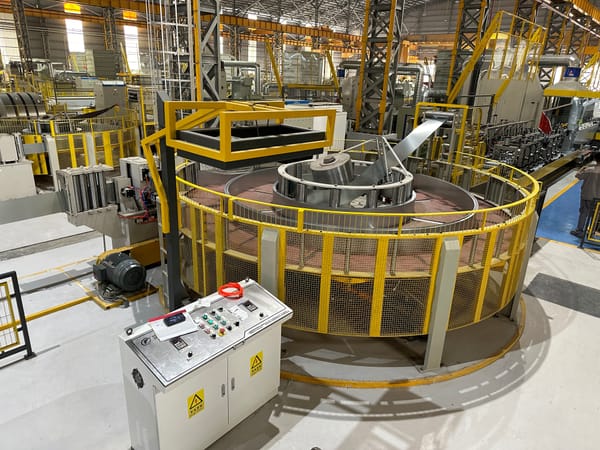
The Loop Accumulator is a crucial component in the ERW tube mill line, positioned after the Shearer & Butt Welder Station and before the forming section. Its primary function is to act as a buffer, storing a reserve of steel strip to ensure continuous operation of the mill during the brief pauses required for shearing and butt welding new coils. This prevents the downstream forming and welding sections from stopping, thereby maintaining high production efficiency and product quality.
Function and Types
When a new coil is being joined, the uncoiling and butt welding processes temporarily halt the strip feed from the entry section. The loop accumulator releases its stored strip to feed the mill during this interval, allowing the forming and welding processes to continue uninterrupted. Once the new coil is welded, the entry section speeds up to replenish the accumulator's reserve. Various types of accumulators exist, including cage accumulators, horizontal spiral accumulators, and rotary (or circular) accumulators. Each type is designed to manage strip storage with different capacities and operational characteristics.
Why Circular Accumulator is Better
Circular accumulators, often referred to as horizontal spiral or rotary accumulators, offer several distinct advantages that make them a preferred choice in many modern ERW tube mills:
1. Large Storage Capacity: Circular designs can typically store a significantly larger amount of steel strip compared to other types like cage accumulators. This increased capacity provides a longer buffer time, allowing for more flexibility during coil changes and reducing the risk of mill stoppages.
2. Reduced Strip Damage: The design of circular accumulators often involves a smoother path for the steel strip, minimizing sharp bends or abrasive contact points. This significantly reduces the likelihood of scratches, dents, or other surface damage to the strip, which could otherwise lead to defects in the finished tube.
3. No Storage Expansion or Shrinkage: Unlike some accumulator designs where the stored loop can expand or shrink, potentially causing tension fluctuations, circular accumulators are designed to maintain a more consistent and controlled strip tension. This stability is vital for uniform feeding into the forming section.
4. Lower Power Consumption: The efficient design and controlled movement of the strip within a circular accumulator can lead to lower energy requirements for operation compared to systems that might involve more complex mechanical movements or higher friction.
5. Smooth and Stable Operation: The continuous, rotational movement of the circular accumulator provides a very stable and consistent feed of material to the mill. This smooth operation contributes to better control over the forming process and ultimately, higher quality tubes.
6. Compact Footprint (Relative to Capacity): While they store a large amount of strip, circular accumulators can often achieve this capacity within a relatively compact footprint, making efficient use of factory floor space.
In essence, the circular accumulator's ability to provide a large, damage-free, and stable supply of steel strip with efficient operation makes it a superior choice for ensuring the continuous, high-quality production demanded by modern ERW tube mills.
